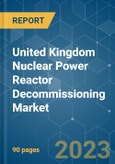The United Kingdom nuclear power reactor decommissioning market is expected to rise at a CAGR of more than 5% during the forecast period.
The market was negatively impacted by COVID-19. Presently the market has now reached pre-pandemic levels.
This product will be delivered within 2 business days.
The market was negatively impacted by COVID-19. Presently the market has now reached pre-pandemic levels.
Key Highlights
- Over the medium period, increasing renewable energy installation, which is cheaper and cleaner, is expected to drive the United Kingdom nuclear power reactor decommissioning market during the forecast period.
- On the other hand, the high cost of decommissioning nuclear plants is expected to restrain the United Kingdom nuclear power reactor decommissioning market.
- Nevertheless, increasing the use of robots and artificial intelligence in the decommissioning of nuclear reactors is safer and will likely create several opportunities for the United Kingdom nuclear power reactor decommissioning market in the future.
UK Nuclear Power Reactor Decommissioning Market Trends
Commercial Power Reactor Expected to Dominate the Market
- Commercial power reactors are nuclear reactors that are mainly used for generating electricity. Most of these reactors are being installed in nuclear power plants. Moreover, increasing renewable energy from solar and wind is much cheaper and cleaner.
- The regulatory body for decommissioning nuclear plants is Nuclear Decommissioning Authority (NDA), a non-departmental public body created through the Energy Act 2004. The authority delivers the decommissioning activity through others, primarily Site Licence Companies (SLCs). Moreover, the agency is expected to achieve the end state for all nuclear sites by 2025.
- In 2021, the total electricity produced by nuclear energy in the United Kingdom was 45.9 terawatt-hours (TWh), which was lower than the previous generation of 50.3 TWh. The country, in recent years, has reduced the usage of nuclear energy to produce electricity. This, in turn, will likely create a massive demand for the nuclear reactor decommissioning market.
- The United Kingdom plans to build new reactors to replace its existing fleet and make up for the diminishing oil & gas reserves. The country is expected to be setting up around 16 GWe of installed nuclear capacity by 2030. This development is expected to be a long-term opportunity for the nuclear decommissioning market.
- In October 2022, the Nuclear Decommissioning Authority (NDA) signed a Memorandum of Understanding (MoU) with Cwmni Egino to support the development of a new small nuclear project in North Wales. As a result of the MoU, the NDA can share information and expertise regarding the characteristics of its land at Trawsfynydd, align decommissioning plans and site activities with the new nuclear project, and assist Cwmni Egino in engaging stakeholders and developing socio-economic plans.
- Hence, owing to the above points, the commercial power rector segment will likely dominate the United Kingdom nuclear power reactor decommissioning market during the forecast period.
Increasing Renewable Energy Expected to Drive the Market
- The increasing share of renewable energy in the country's total energy generation is for the country's plan to reduce its carbon footprint in the environment. Moreover, renewable energy sources being cheaper and safer are likely going to drive the nuclear power reactor decommissioning market.
- The scheme, such as renewable obligation (RO), is intended to encourage renewable electricity generation for large-scale installations. It requires suppliers to source an ever-increasing amount of electricity from renewable sources. The RO rewards renewable output over the lifetime of a project.
- In 2021, the total renewable energy installation capacity in the United Kingdom was 50.29 gigawatts (GW), greater than the country's installed capacity of 2020, 47.39 GW. The increasing capacity of renewable energy in the country exhibits a cheaper and safer form of generating electricity, which is expected to drive the nuclear power reactor decommissioning market.
- The country's Feed-in Tariff (FiT) is designed to support small-scale renewable installations up to 5MW. Through FiTs, generators are paid a tariff for every unit of electricity they produce. Any power not used on-site can also be sold back into the Grid, and generators are paid extra to do this.
- Hence, owing to the above points, increasing renewable energy is expected to drive the United Kingdom nuclear power reactor decommissioning market during the forecast period.
UK Nuclear Power Reactor Decommissioning Market Competitor Analysis
The United Kingdom nuclear power reactor decommissioning market is moderately fragmented. Some key players in this market (not in a particular order) include Babcock International Group PLC, James Fisher & Sons PLC, Fluor Corporation, Studsvik AB, and Orano Group., among others.Additional benefits of purchasing the report:
- The market estimate (ME) sheet in Excel format
- 3 months of analyst support
This product will be delivered within 2 business days.
Table of Contents
1 INTRODUCTION
4 MARKET OVERVIEW
5 MARKET SEGMENTATION
6 COMPETITIVE LANDSCAPE
Companies Mentioned (Partial List)
A selection of companies mentioned in this report includes, but is not limited to:
- Babcock International Group PLC
- James Fisher & Sons PLC
- Fluor Corporation
- Studsvik AB
- Aecom
- Orano Group
- Bechtel Group, Inc.
- SNC-Lavalin Group (Atkins)
Methodology

LOADING...










